Logistics
Rio Grande do Sul is located in a strategic central position in relation to the neighboring countries of Mercosur, which concentrates more than 70% of the population and GDP of South America within a radius of up to 1500km. The State borders with 2 Mercosur countries, Uruguay and Argentina. There is direct and easy access to the largest consumer markets in South America.
highways
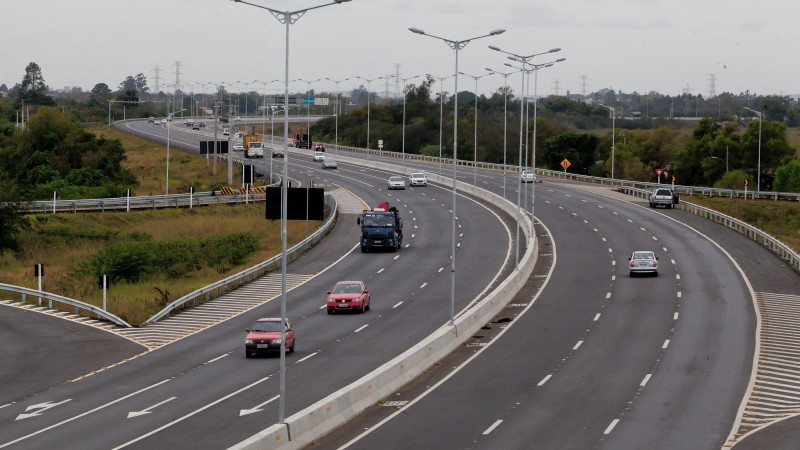
The road system predominates in Rio Grande do Sul: more than 80% of passengers and cargo are transported by this route, which reaches 17,200 kilometers in length. Easy access to neighboring Argentina and Uruguay is one of the main differentials of the State. Among the main highways in Rio Grande do Sul are the BR-101, which connects Rio Grande do Sul to 11 other states; the BR-116, which comes from Ceará, passes through 10 Brazilian states and reaches Jaguarão, on the Brazilian border with Uruguay; the BR-290, which crosses the state from the North Coast towards the West, reaching Argentina; the BR-472, which crosses the extreme west of Rio Grande do Sul and reaches Barra do Quaraí, on the triple border between Brazil, Uruguay and Argentina; and the BR-285, which starts in Santa Catarina and reaches São Borja, a municipality in the state that borders Argentina. The State has the fourth largest vehicle fleet in Brazil, representing 6.9% of the national total (CNT, 2022)
Waterways and Ports
The hydroport system in the State of Rio Grande do Sul is divided into public ports, leased terminals and private terminals. There are more than 754 km of waterways with ample capacity to receive new industrial complexes. There are 3 public ports in the State, namely, the Port of Rio Grande, the Port of Pelotas and the Port of Porto Alegre.
In terms proportional to its area, RS is the Brazilian state with the largest length of navigable waterways, 754 kilometers. The rivers, lakes and ponds with this function are divided into three hydrographic basins: Uruguay, Guaíba and Litorânea. The main navigable rivers are concentrated in these last two, in the eastern region of the State. The connection with Uruguay is one of the main competitive advantages of Rio Grande do Sul hydrography. In addition, the State has ports in different regions, the main ones being Porto Alegre, Rio Grande and Pelotas. The main route is Porto Alegre-Rio Grande, which mainly transports petrochemical products, petroleum derivatives, soy bran and oil, and cellulose.
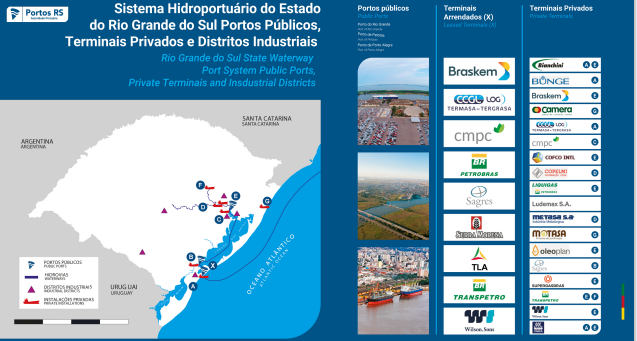
Port of Rio Grande
The Port of Rio Grande is the busiest. In the first four months of 2023, from January to April, the Port of Rio Grande had a handling of Weight (tons) of 12,729,820t with a positive variation of 7.70% 2021/2023 and 6.03% 2022/2023. Handling by cargo segment was 3,667,482t of general cargo, 7,746,016t of solid bulk and 1,316,322t of liquid bulk. The emphasis on goods being shipped, unloaded and in transit was concentrated on the following goods: wheat, soy bran, cellulose, soy beans, rice, phosphate, potassium chloride, wood chips, wood, corn). The movement of containers (in TEUs) in the Port of Rio Grande from January to April 2023 increased by 9.75% and totaled 190,842 containers; being 112,987 full and 77,855 empty.
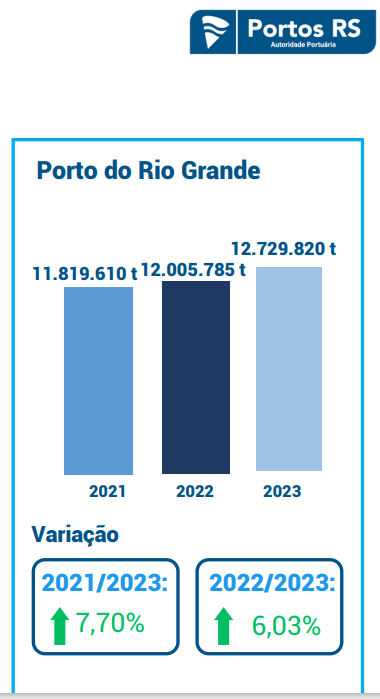
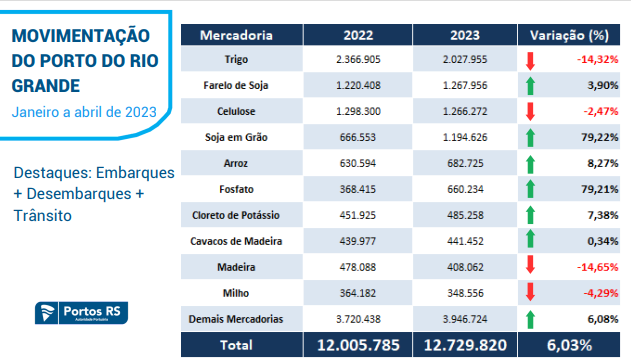
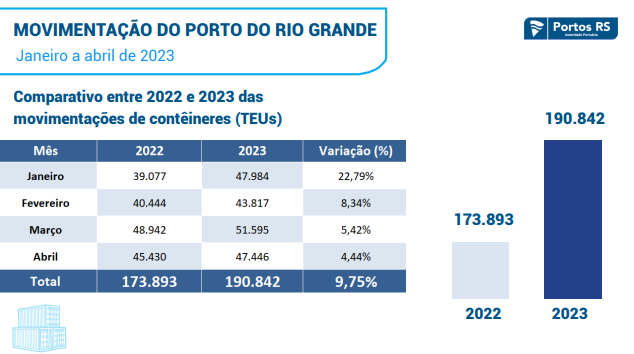
Imports from the Port of Rio Grande, in the first four months of 2023, totaled 2,614,585t and mainly originated in the following countries: Argentina, China, Canada, Morocco and Russia. Exports, in the same period, totaled 7,356,011t and were mainly destined for the following countries: China, Indonesia, Vietnam, Portugal, Saudi Arabia. As ranked below:
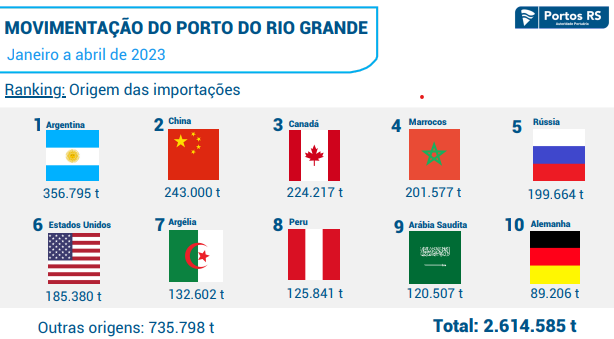
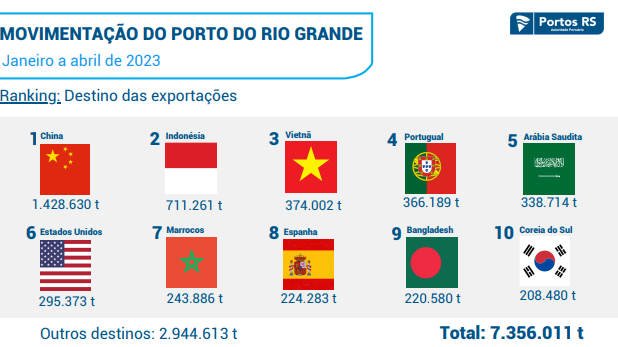
The State of Rio Grande do Sul launched the Port Energy Platform Project that seeks to attract investments in the energy sector, in particular projects related to the wind industry and green hydrogen for the Port of Rio Grande.
airports
 Rio Grande do Sul has airports in different municipalities. The main ones, in addition to Porto Alegre – Salgado Filho International Airport, are in the cities of Caxias do Sul, Passo Fundo and Pelotas.
Rio Grande do Sul has airports in different municipalities. The main ones, in addition to Porto Alegre – Salgado Filho International Airport, are in the cities of Caxias do Sul, Passo Fundo and Pelotas.
Porto Alegre – Salgado Filho International Airport
Salgado Filho Airport is one of the most important in the country, with direct connections to Europe and South and Central America. It is the third in number of international passengers, behind only Galeão, in Rio de Janeiro, and Guarulhos, in São Paulo.
With more than 50 thousand square meters of built area, distributed between two terminals, the airport can simultaneously receive up to 25 large aircraft. There are 32 check-in counters and five departure and arrival bridges. The Porto Alegre airport is undergoing works that will increase the area of Terminal 2 from 37,200 m² to 76,000 m². One of the differentials of Salgado Filho is the location: located in the North Zone of the Capital, the airport is just 10 kilometers from the city center, with less than 30 minutes of travel.
With an investment of BRL 135 million, the company Fraport, concessionaire of the Salgado Filho International Airport in Porto Alegre, completed, in the first half of 2022, the work to expand the runway for takeoffs and landings. The layout of the new runway was expanded by 920 meters, totaling 3.2 kilometers. The new design paves the way mainly for cargo transport, as the runway now accommodates large aircraft.